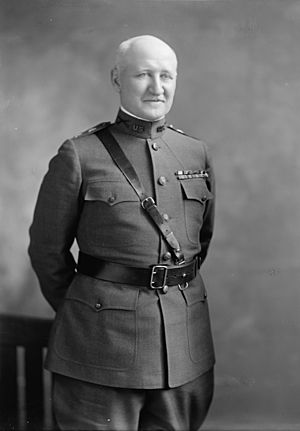Charles S. Farnsworth facts for kids
Quick facts for kids
Charles Stewart Farnsworth
|
|
|---|---|
 |
|
| Born | October 29, 1862 Lycoming County, Pennsylvania, United States |
| Died | December 19, 1955 (aged 93) the Naval Hospital in Norco, California, United States |
| Allegiance | |
| Service/ |
|
| Years of service | 1887–1925 |
| Rank | |
| Service number | 0-26 |
| Unit | |
| Commands held | 159th Brigade 37th Division United States Army Infantry School |
| Battles/wars | Spanish–American War World War I |
| Awards | Army Distinguished Service Medal Silver Star Croix de Guerre with Palm (France) Legion of Honor (France) Order of Léopold (Belgium) |
Major General Charles Stewart Farnsworth (born October 29, 1862 – died December 19, 1955) was an Army officer and a leader in his community. He served in important wars and helped build military bases.
Contents
Early Life and Education
Charles Farnsworth was born in Lycoming County, Pennsylvania. He went to local schools there. Before joining the military, he worked for companies like Western Union and Bell Telephone. In 1883, he was accepted into the United States Military Academy (USMA) in West Point, New York. This is a famous school for training Army officers.
Military Career Highlights
After graduating from West Point, Farnsworth was sent to different Army posts. These included Fort Sisseton in South Dakota and Fort Buford in North Dakota. In 1893, he became a professor at the University of North Dakota. He taught military science and tactics. He even coached the school's football team from 1895 to 1896.
Serving in Wars and Building Forts

During the Spanish–American War, Farnsworth worked as a quartermaster in Cuba. A quartermaster is an officer who handles supplies and housing for soldiers.
After this war, he went to Alaska. There, he helped create and build Fort Gibbon. He then moved to the Philippines and helped build Fort William McKinley. He also expanded military camps in San Francisco.
Farnsworth continued his military education. He attended the U.S. Army Command and General Staff School in 1909. He also graduated from the U.S. Army War College in 1916. These schools train officers for higher leadership roles.
He also served during the Pancho Villa Expedition into Mexico. In this mission, he commanded a group of soldiers and managed a supply base.
World War I Service
When the United States joined World War I in 1917, Farnsworth became the leader of the U.S. Army Infantry Training School at Fort Sill. An infantry school teaches soldiers how to fight on foot. Later, he commanded the 159th Infantry Brigade. This group was part of the 80th Infantry Division.
In 1918, Farnsworth was promoted to major general. He took command of the 37th Infantry Division. He led this division to the Western Front in Europe. His division fought in important battles like the Battle of Saint-Mihiel and the Meuse–Argonne offensive.
For his brave service in World War I, Farnsworth received several awards. These included the Army Distinguished Service Medal and the Silver Star from the U.S. Army. He also received awards from other countries, such as the Croix de Guerre with Palm and the Legion of Honor from France. Belgium gave him the Order of Léopold.
Post-War Leadership and Retirement
After World War I, Farnsworth organized the U.S. Army Infantry School at Fort Benning, Georgia. He was its first leader. In 1920, he became the Chief of Infantry. This meant he was in charge of all infantry units in the U.S. Army. He held this important position until he retired in 1925. As Chief of Infantry, he traveled to inspect reserve units and R.O.T.C. programs.
Later Life and Community Work
After retiring from the Army in 1925, General Farnsworth and his wife moved to Altadena, California. They became very active in their community. He was the president of the Altadena Citizens' Association. He also led the Altadena Beautification League, which worked to make the town look nicer. He was also a member of the Los Angeles County Planning Commission.
In 1931, Farnsworth was chosen as the Grand Marshal for the famous Tournament of Roses. He was one of the few people in modern times to ride a horse down the parade route.
Farnsworth played a big role in creating Altadena Park in 1934. He helped raise money for the park. He also designed it and supervised its construction. In 1939, the park was renamed in his honor.
His wife passed away in 1951. Charles Stewart Farnsworth died in 1955 at a hospital in Norco, California. Both he and his wife are buried at the cemetery in the Presidio of San Francisco.
Personal Life
Charles Farnsworth married Laura Galey while he was stationed at Fort Shaw. They had one son named Robert. Laura passed away in 1890.
In 1894, he married Helen Bosard. They did not have any children together.
Images for kids
Additional Reading
- "Milestones". Time, January 2, 1956, p. 57.
- "In Memory". Assembly, Association of Graduates, U.S.M.A. West Point, New York: United States Military Academy, Vol. XV, No. 1, April 1956, p. 57.
- Peterson, Robert H. Altadena's Golden Years Alhambra, California: Sinclair Printing and Litho, Inc. 1976.
- "Rose Parade Head Named". Los Angeles Times, December 16, 1930 Part II, p. 2.
- Zack, Michele. Altadena: Between Wilderness and City Altadena, California: Altadena Historical Society, 2004 ISBN: 0-9747257-0-6


